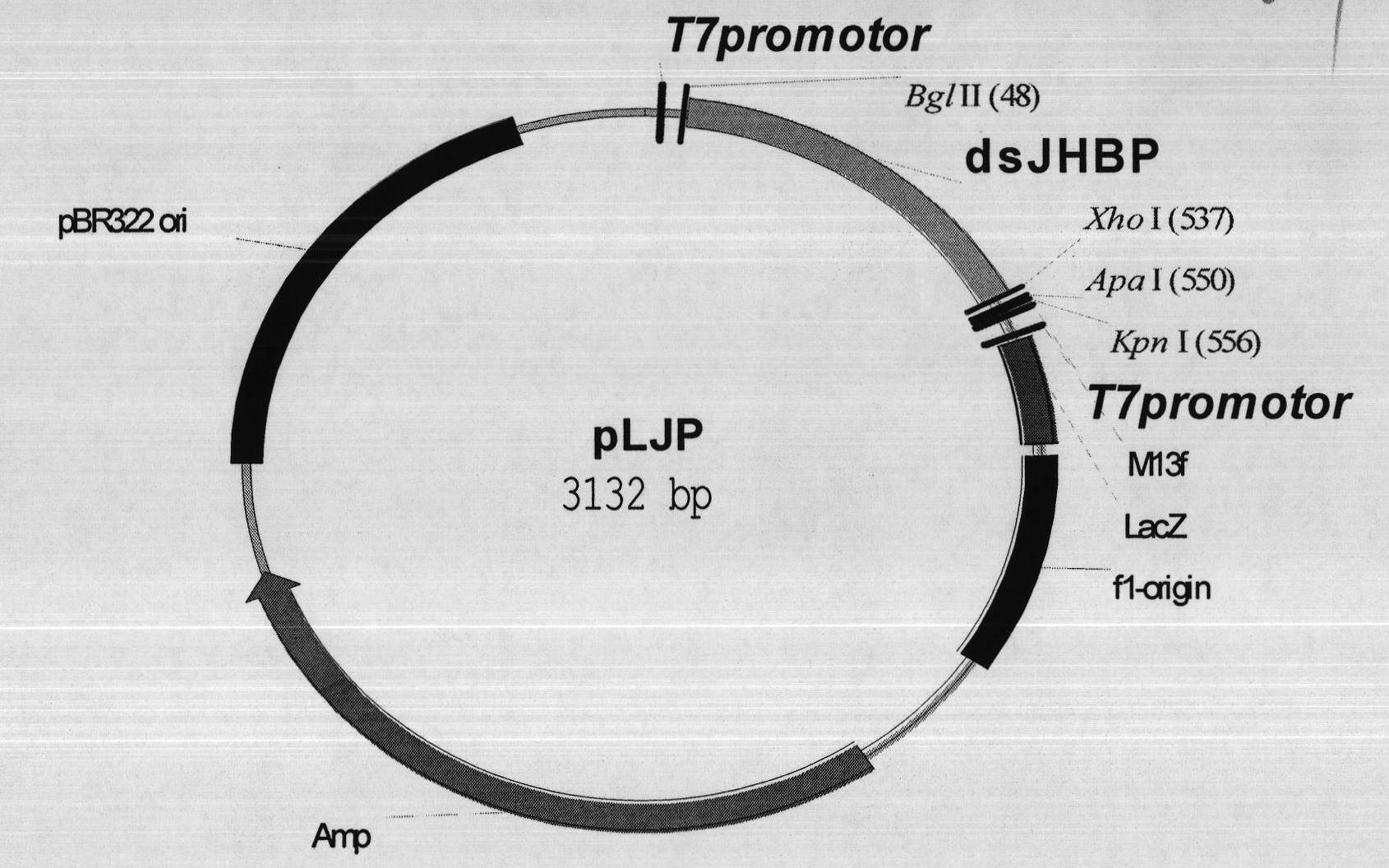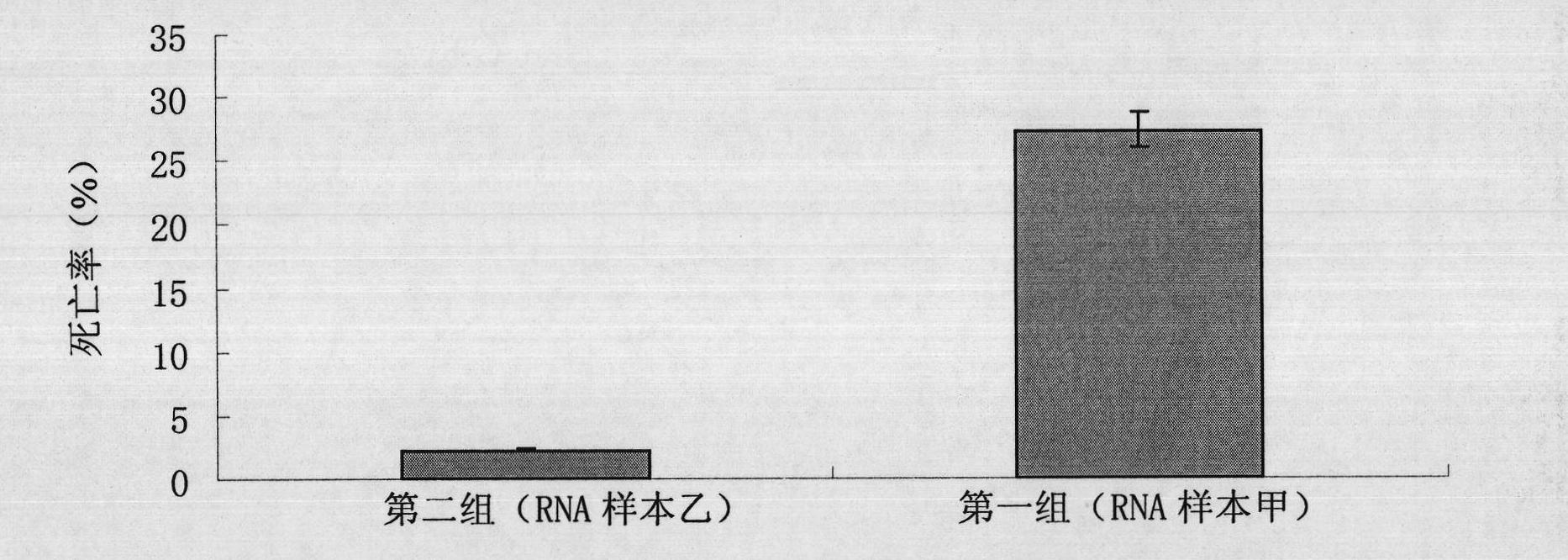Helicoverpa armigera juvenile hormone binding protein (Ha-JHBP) and encoding gene and application thereof
Cotton bollworm, coding technology, applied in application, genetic engineering, plant genetic improvement, etc., can solve the problem of slow development of transgenic plant resistance, etc., and achieve the effect of improving insect resistance
- Summary
- Abstract
- Description
- Claims
- Application Information
AI Technical Summary
Problems solved by technology
Method used
Image
Examples
Embodiment 4
[0053] The sterile tobacco variety used in Example 4 is Nicotiana tabacum cv.Xanthi, and the public can obtain it from the Institute of Genetics and Developmental Biology, Chinese Academy of Sciences; References: A.NATO, S.BAZETOUX, Y.MATHIEUPhotosynthetic Capacities and Growth Characteristics of Nicotiana tabacum (cv. Xanthi) Cell Suspension Cultures Physiologia Plantarum Volume 41, Issue 2, pages 116-123, October 1977.
[0054] Cotton bollworm (Helicoverpa armigera): publicly available from the Institute of Genetics and Developmental Biology, Chinese Academy of Sciences; references: Wu KM, Lu YH, Feng HQ, Jiang YY, Zhao JZ. Suppression of cotton bollworm in multiple crops in China in areas with Bt toxin-containing cotton. Science. 2008 Sep 19;321(5896):1676-8.
[0055] LB medium: the solvent is water, containing yeast extract 5g / L, peptone 10g / L, NaCl 10g / L, and the pH is adjusted to 7.0 with 10M NaOH aqueous solution.
[0056] YEB medium: the solvent is water, containing b...
Embodiment 1
[0061] Embodiment 1, discovery of juvenile hormone-binding protein and its coding gene of cotton bollworm
[0062] 1. According to the JHBP gene sequence of known insects, the degenerate primers (P1 / P2) are designed as follows:
[0063] P1: 5'-AGTGA(C / T)ATA(A / G)AATGC(T / A)T(G / A)AGCAA-3';
[0064] P2: 5'-GG(C / T)TC(T / A)CCAA(T / A)GATTTC(A / G)CAAG-3'.
[0065] 2. Extract the total RNA of the 3rd instar cotton bollworm larvae, and obtain cDNA by RT-PCR in vitro reverse transcription.
[0066] 3. Using the cDNA in step 2 as a template, perform PCR amplification with the primers designed in step 1 to obtain a PCR amplification product.
[0067] 4. Cloning the PCR amplified product in step 3 into the pEASY-Blunt sequencing vector for sequencing. The sequencing results showed that the nucleotide sequence of the PCR amplified product was shown in sequence 5 in the sequence table.
[0068] 5. Extract the total RNA of the 3rd instar cotton bollworm for the primer extension experiment, add...
Embodiment 2
[0083] Embodiment 2, cotton bollworm larvae feeding test
[0084] 1. Construction of recombinant plasmid pLJP
[0085] 1. Using the recombinant plasmid pJHBP as a template, carry out PCR amplification with primers P7-BglII / P8-XhoI, and recover the PCR amplification product (the conserved segment of Ha-JHBP gene JHBP1-BX).
[0086] P7-BglII: 5'-GAAGATCTGATGTTGTGTATGA-3';
[0087] P8-XhoI: 5'-CCGCTCGAGTTAAAAGTCGTGGT-3'.
[0088] 2. The PCR amplification product of step 3 was double-digested with restriction enzymes BglII and XhoI, and the digested product was recovered.
[0089] 3. Digest the bacterial expression vector L4440 with restriction endonucleases BglII and XhoI, and recover the vector skeleton.
[0090] 4. Ligate the digested product of step 2 with the vector backbone of step 3 to obtain the recombinant plasmid pLJP. The starting vector of the recombinant plasmid pLJP is L4440, and the DNA shown in the 204-691 nucleotides of the sequence 2 of the sequence listing f...
PUM
 Login to View More
Login to View More Abstract
Description
Claims
Application Information
 Login to View More
Login to View More - R&D
- Intellectual Property
- Life Sciences
- Materials
- Tech Scout
- Unparalleled Data Quality
- Higher Quality Content
- 60% Fewer Hallucinations
Browse by: Latest US Patents, China's latest patents, Technical Efficacy Thesaurus, Application Domain, Technology Topic, Popular Technical Reports.
© 2025 PatSnap. All rights reserved.Legal|Privacy policy|Modern Slavery Act Transparency Statement|Sitemap|About US| Contact US: help@patsnap.com



